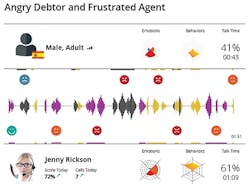Telecom Embraces Emotion AI
(Telecom) satisfaction rates range between 11% and 25%, depending on the length of service. The more often someone switches providers, the less likely they are to be satisfied with their service. With 90% of US adults using the Internet regularly, that’s a lot of people with a lot of potential dissatisfaction. Can AI help?
Artificial intelligence (AI) represents one of the most significant, enduring technological innovations of our time. Despite the persistent fear that AI will displace millions from their jobs, the World Economic Forum estimates as many as 58 million net new jobs will be created in the next few years. There is a good reason for this. Far from a plug-and-play tool for a specific use case, AI represents a fundamental shift in how we look at complex business problems. With that being said, nowhere is that shift more evident than in the case of emotional artificial intelligence — the ability for machines to be emotionally intelligent — or simply put: Emotion AI.
While AI has become a mainstay in American businesses (34% of those investing spend $5M+ per year and more than 50% are expected to increase their investment by 10% or more), Emotion AI represents the next evolution of the technology, enabling developers to program complex systems to recognize intricate signals in the human voice representing as many as 50 unique emotions. For telecom service providers, this represents a significant shift in how data is captured, customers are managed, and decisions are made. Let’s take a closer look at how AI is already impacting telecom businesses and what emotion AI in particular represents.
InvisiLight® Solution for Deploying Fiber
April 2, 2022Go to Market Faster. Speed up Network Deployment
April 2, 2022Episode 10: Fiber Optic Closure Specs Explained…
April 1, 2022Food for Thought from Our 2022 ICT Visionaries
April 1, 2022Emotionally Savvy Data
Most voice technology has, until very recently, relied heavily on only the quantitative data in our speech. In other words, quantitative data being the specific words and phrases we use to describe a request. Our personal voice assistants, such as Alexa or Google Home, process billions of such requests every day. Similarly, many telecom companies leverage such tools and capabilities for customer service lines to guide customers to the correct resource.
With the implementation of Emotion AI, systems can now not only measure quantitative data, but also qualitative data. This new data set includes reactions and behaviors such as voice intonation, emotional prosody, and the subtext of a conversation, based on hundreds of signals encoded in regular human speech. Things like speed, pitch, volume, timbre, and the space between words, can tell a detailed story of the speaker’s intention, emotional state, and likely next actions. The result is a highly detailed map of a conversation that supports the quantitative data of a conversation.
Where voice stands out particularly is the sheer depth of signals offered by someone in a conversation. Research shows it is substantially harder for someone to hide their emotions in speech than on their face.
The result is a wealth of new data. Instead of data points like "reason for cancelation", databases can take into account that the speaker was in a hurry, mildly frustrated, and only partially paying attention, during the conversation with an agent. That "impatience" becomes a data point that can be measured and evaluated against their history as a customer to inform not only how to handle similar situations but to also potentially recapture them in the future.
Improving the Customer Experience
Emotion AI is already being implemented in a range of industries to take advantage of these new insights. In customer service, in particular, companies like Allstate, IBM, MetLife and more are using AI systems to capture and utilize a significant volume of data on their customers, often in real time.
For the telecom industry, this is particularly important. Already fighting an uphill battle against customer disengagement and preconceptions of what to expect, many telecom companies fight against decades-old reputations that undermine even the simplest of customer service interactions.
Satisfaction rates range between 11% and 25% depending on the length of service, and the more often someone switches providers, the less likely they are to be satisfied with their service. With 90% of US adults using the Internet regularly, that’s a lot of people with a lot of potential dissatisfaction.
Emotion AI offers a frontline defense against customer concerns. AI agents are developed to provide real-time feedback on the performance of a customer service agent and the potential emotional state of the customer on service calls. AI systems are being used to guide and support customers with questions to ensure they reach the correct service agent faster and spend less time on the phone. Other systems are being used to analyze the entirety of phone conversations and identify when a customer’s emotional state changed and how the service agent should respond.
Customer service agents are subject to the same emotional impacts as their customers, and often don’t realize when their mood changes in the midst of a call. They will often mirror and respond to the negative emotions displayed by a customer, and the call can quickly snowball. Emotion AI provides a combination of real-time feedback during a call and post-call analysis to identify these inflection points and minimize disruption.
From a customer perspective, everything is improved. They reach the correct agent faster, receive more responsive service, and report a higher rate of resolution.
Improve Internal Effectiveness
Internally, Emotion AI helps provide a better baseline for performance evaluation and, in turn, informs the customer service strategy.
Behavioral Performance Scores, for example, were traditionally measured by listening to recorded CSR calls and assessing the performance of an agent. Even the best managers would struggle to be completely objective. Thus, it was nearly impossible to provide consistent guidelines across a large organization.
• AI addresses this by evaluating calls, both recorded and in real time, to assess the performance of a customer service agent, based not only on the outcome of the call but also the emotional response of the customers.
• This helps to inform how agents are trained to improve important soft skills and emotional intelligence on calls.
• It also ensures greater compliance and reputation management and reduces employee attrition by empowering them to perform better and manage tough situations.
Bain and Company estimate that improvements to customer retention can have an outsized impact on profits, with just 5% resulting in an additional 25%-95%. The cost of acquiring new customers is such that many companies have started investing heavily in retention, and AI can help to not just improve those results but to provide valuable insights into areas for further training and subsequent improvement.
The Long-Term Impact
Telecom providers can improve their internal and external efficacy by leveraging AI software from companies like Behavioral Signals.
Figure 1. A snapshot of call emotion recognition software platform that provides an audio-visual summary of the agent and customer behaviors, as well as key indicators (KPIs).
Figure 1 shows a snapshot of their call emotion recognition software platform (callER, commercially available as Oliver API) that provides an audio-visual summary of the agent and customer behaviors, as well as key indicators (KPIs), to understand the "how", "what", and "why" of words that have been spoken in a conversation. This is essential for monitoring the health of your call center, and taking the appropriate executive decisions in order to measure customer satisfaction, agent performance, propensity to buy/pay/donate, and overall call success, thereby increasing customer retention and acquisition, and reducing agent training.
Conversational analytics helps identify key behaviors that might lead someone to act in a certain way. With this helpful data available in real time, agents can provide an extra layer of service with information they would not have had before.
Like this Article?
Subscribe to ISE magazine and start receiving your FREE monthly copy today!
Resources
The Future of Jobs 2018. World Economic Forum. http://reports.weforum.org/future-of-jobs-2018/
Future in the balance? How countries are pursuing an AI advantage. Deloitte. https://www2.deloitte.com/us/en/insights/focus/cognitive-technologies/ai-investment-by-country.html
Allstate’s ‘Digital Colleague’ Amelia Answers Questions For Call Center Reps. CIO Journal. The Wall Street Journal. https://blogs.wsj.com/cio/2018/03/30/allstates-digital-colleague-amelia-answers-questions-for-call-center-reps/
The Value of Keeping the Right Customers. By Amy Gallo. Harvard Business Review. October 29, 2014. https://hbr.org/2014/10/the-value-of-keeping-the-right-customers
About the Author






